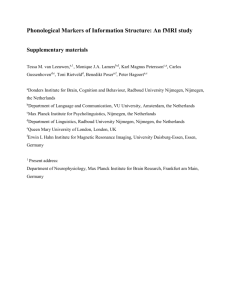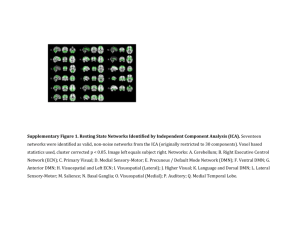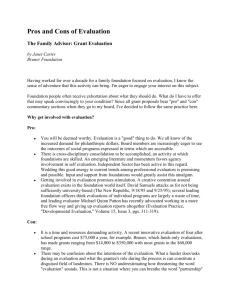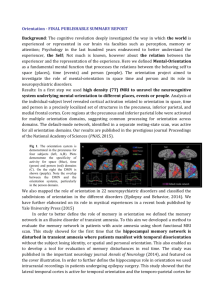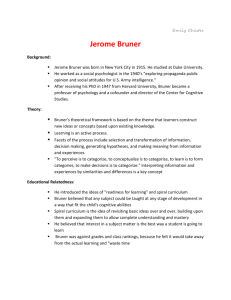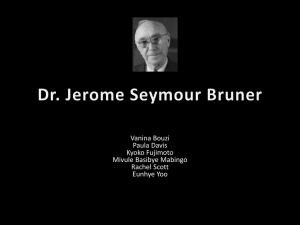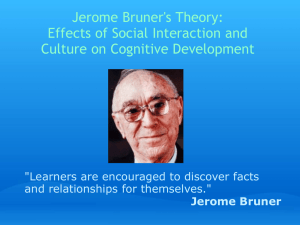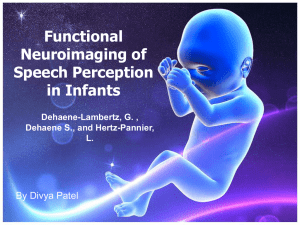Midsagittal brain variation and MRI shape analysis of the precuneus
advertisement
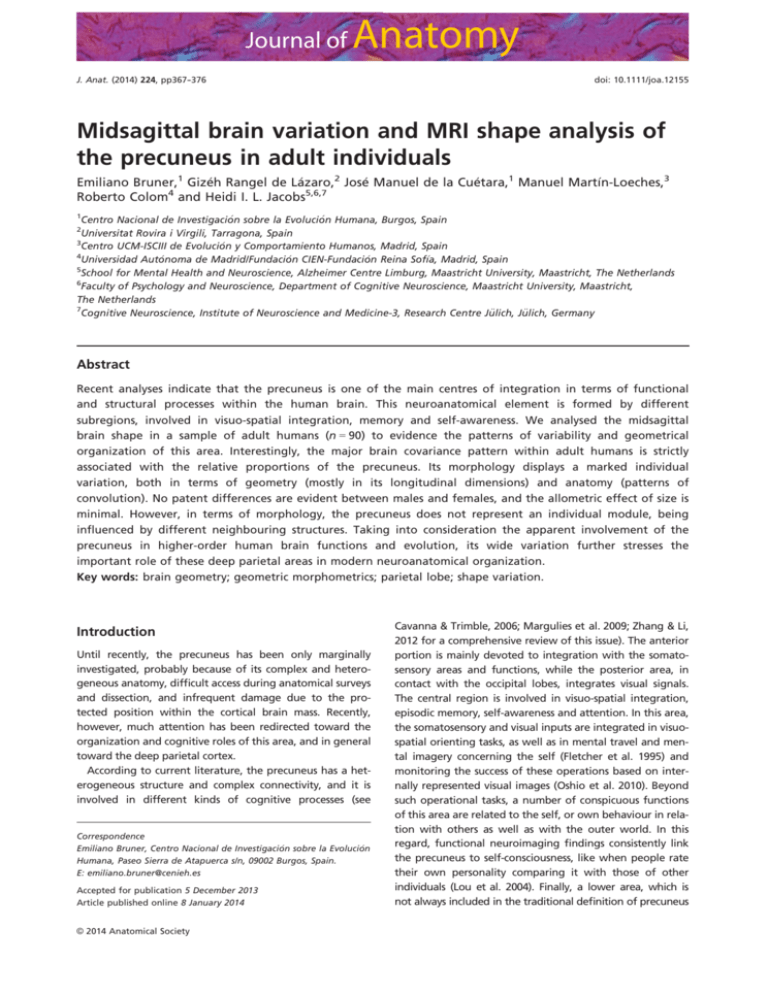
Journal of Anatomy J. Anat. (2014) 224, pp367--376 doi: 10.1111/joa.12155 Midsagittal brain variation and MRI shape analysis of the precuneus in adult individuals h Rangel de La zaro,2 Jose Manuel de la Cue tara,1 Manuel Martın-Loeches,3 Emiliano Bruner,1 Gize 4 5,6,7 Roberto Colom and Heidi I. L. Jacobs n sobre la Evolucio n Humana, Burgos, Spain Centro Nacional de Investigacio Universitat Rovira i Virgili, Tarragona, Spain 3 n y Comportamiento Humanos, Madrid, Spain Centro UCM-ISCIII de Evolucio 4 noma de Madrid/Fundacio n CIEN-Fundacio n Reina Sofıa, Madrid, Spain Universidad Auto 5 School for Mental Health and Neuroscience, Alzheimer Centre Limburg, Maastricht University, Maastricht, The Netherlands 6 Faculty of Psychology and Neuroscience, Department of Cognitive Neuroscience, Maastricht University, Maastricht, The Netherlands 7 € lich, Ju € lich, Germany Cognitive Neuroscience, Institute of Neuroscience and Medicine-3, Research Centre Ju 1 2 Abstract Recent analyses indicate that the precuneus is one of the main centres of integration in terms of functional and structural processes within the human brain. This neuroanatomical element is formed by different subregions, involved in visuo-spatial integration, memory and self-awareness. We analysed the midsagittal brain shape in a sample of adult humans (n = 90) to evidence the patterns of variability and geometrical organization of this area. Interestingly, the major brain covariance pattern within adult humans is strictly associated with the relative proportions of the precuneus. Its morphology displays a marked individual variation, both in terms of geometry (mostly in its longitudinal dimensions) and anatomy (patterns of convolution). No patent differences are evident between males and females, and the allometric effect of size is minimal. However, in terms of morphology, the precuneus does not represent an individual module, being influenced by different neighbouring structures. Taking into consideration the apparent involvement of the precuneus in higher-order human brain functions and evolution, its wide variation further stresses the important role of these deep parietal areas in modern neuroanatomical organization. Key words: brain geometry; geometric morphometrics; parietal lobe; shape variation. Introduction Until recently, the precuneus has been only marginally investigated, probably because of its complex and heterogeneous anatomy, difficult access during anatomical surveys and dissection, and infrequent damage due to the protected position within the cortical brain mass. Recently, however, much attention has been redirected toward the organization and cognitive roles of this area, and in general toward the deep parietal cortex. According to current literature, the precuneus has a heterogeneous structure and complex connectivity, and it is involved in different kinds of cognitive processes (see Correspondence n sobre la Evolucio n Emiliano Bruner, Centro Nacional de Investigacio Humana, Paseo Sierra de Atapuerca s/n, 09002 Burgos, Spain. E: emiliano.bruner@cenieh.es Accepted for publication 5 December 2013 Article published online 8 January 2014 © 2014 Anatomical Society Cavanna & Trimble, 2006; Margulies et al. 2009; Zhang & Li, 2012 for a comprehensive review of this issue). The anterior portion is mainly devoted to integration with the somatosensory areas and functions, while the posterior area, in contact with the occipital lobes, integrates visual signals. The central region is involved in visuo-spatial integration, episodic memory, self-awareness and attention. In this area, the somatosensory and visual inputs are integrated in visuospatial orienting tasks, as well as in mental travel and mental imagery concerning the self (Fletcher et al. 1995) and monitoring the success of these operations based on internally represented visual images (Oshio et al. 2010). Beyond such operational tasks, a number of conspicuous functions of this area are related to the self, or own behaviour in relation with others as well as with the outer world. In this regard, functional neuroimaging findings consistently link the precuneus to self-consciousness, like when people rate their own personality comparing it with those of other individuals (Lou et al. 2004). Finally, a lower area, which is not always included in the traditional definition of precuneus 368 Shape analysis of the precuneus, E. Bruner et al. and that generally fades into the retrosplenial and cingulate cortex, displays connections with subcortical elements. These lower areas also represent a major hub in the human brain default mode system, being activated during resting conscious states. Such hub properties are related to its extensive connections with other brain regions. The precuneus is connected with all the other parietal elements, mostly the intraparietal sulcus and the angular gyrus. The main extra-parietal connections of the precuneus run from and toward the frontal lobes. Such extended connectivity makes this region highly metabolic, producing a very high basal metabolic rate. This in turn renders the precuneus vulnerable to all kinds of pathology (Buckner et al. 2008). No patent hemispheric lateralization has been described for this area. Some differences between males and females in connectivity patterns have been evidenced, which merit further attention (Zhang & Li, 2012). In terms of functions and cognition, the precuneus and posterior cingulate gyrus conform to a relatively unitary functional brain area involved in a number of higher-order cognitive processes. The posterior cingulate area also plays a relevant role in episodic memory, particularly in recalling episodes related to the self (Lundstrom et al. 2003, 2005). Similarly to the precuneus, the posterior cingulate area is also involved in somatomotor and visual discrimination processes (Schubert et al. 1998; Deary et al. 2004), while its core functions significantly relate to higher-order cognitive processes of the self, including self-reflection (Johnson et al. 2002), empathy (Farrow et al. 2001) and self/other distinction (Ruby & Decety, 2004). The posterior cingulate gyrus is also central in monitoring one’s own behaviour in space (Vogt et al. 1992), and pertains to the default mode network as well (Buckner et al. 2008). In a number of functions, the posterior cingulum and the precuneus appear to be co-activated, working in tandem. Most of these co-activations relate to overall conscious comprehension processes, like when one understands a whole tale or narrative, compared with fragmentary (mis)understanding of a story (Martın-Loeches et al. 2008). Overall, the posterior cingulate gyrus and the precuneus seem to be a discrete functional unit that is crucial for the processing of conscious information (Vogt & Laureys, 2005). In synthesis, the precuneus is thought to be mainly involved in mental representations and self-consciousness, following integration between visuo-spatial inputs and memory (Fig. 1a). The application of geometric models to neuroanatomy allows morphometric considerations that go well beyond simple volumetric comparisons (Bruner et al. 2010). Brain form can change as a consequence of element-specific volumetric variations reordering the spatial organization of the rest of the anatomical component. Alternatively, form differences can be the result of changes in the relative position of neural elements. In both cases, some brain form changes may be the result of actual neural reorganization (in ontogeny or phylogeny), while others can be the result of secondary spatial adjustments induced by cranial architecture, with no definite neural functional change (Bruner, 2007). In terms of functions, a geometrical change can be the direct consequence of specific functional adaptations, or else a passive spatial reorganization of the anatomical system. Even in this latter case, changes in geometry can secondarily induce changes in functions, like in the case of brain form, connectivity and heat dissipation (Bruner et al. 2012a). By using geometric morphometrics and landmark-based approaches, in recent years we have analysed the midsagittal human brain morphology (Bruner et al. 2010) and the corpus callosum (Bruner et al. 2012b) in adult humans. According to our previous analyses, brain shape displays scarce integration between elements, suggesting a relative morphological independence between the main neural areas. The allometric component is scanty, and there is little sexual dimorphism, if any. The morphology of the cortical and subcortical areas is not correlated, while the posterior areas show a partial level of integration. The most evident covariance is associated with bulging of the fronto-parietal cortex. This is particularly interesting, taking into account that parietal bulging also represents the main shape variation associated with the origin of the modern human brain (Bruner, 2004). In particular, those results point towards changes in the deep parietal volume as being responsible for the observed variation. However, a detailed shape analysis of the medial parietal element is still missing. In the present study, we apply the same techniques to evaluate brain shape variation at the precuneus, investigating the role of this area in shaping the overall brain geometry in adult humans. Materials and methods Midsagittal MRI scans (3.0T GE scanner, T1-weighted, voxel size = 0.469 9 0.469 9 1 mm) from 90 young adult individuals (49 females, 41 males; age range 18–27 years) were selected according to the possibility to recognize the limits and morphology of the precuneus (see Bruner et al. 2010 for more information on the sample and the scanning procedure). Eighteen 2D cortical and subcortical landmarks were used as a geometrical model of the midsagittal brain morphology, including the principal boundaries of the precuneus (Fig. 1b). The anterior profile and the precuneal cortical profile were delimited by the crista galli, the postcentral sulcus and the perpendicular sulcus, respectively. The anterior cortical profile was modelled with three equally distant semi-landmarks, while the precuneus upper profile with one equally distant semi-landmark between the homologous landmarks. Landmarking was performed and revised by three of us (EB, GRL, JMC) to achieve a robust agreement on landmark positions. As the precuneus has no clear morphological boundaries, operational choices were made to analyse the form of the whole area. The marginal ramus of the cingulate sulcus and the perpendicular sulcus (parieto-occipital fissure) are easily visible in most specimens. © 2014 Anatomical Society Shape analysis of the precuneus, E. Bruner et al. 369 Fig. 1 The precuneus receives somatosensorial information from the anterior cortex, visual information from the posterior areas, and it is directly connected with the subcortical elements in its inferior boundaries (a) (redrawn after Margulies et al. 2009). In this study, we used 18 landmarks, sampled as 2D coordinates from the midsagittal MRI section (b) (CAS, calcarine sulcus; CC, centre of cerebellum; CG, crista galli; CO, colliculi; GE, genu; IOP, internal occipital protuberance; MB, midbrain; OC, optic chiasm; PCS, postcentral sulcus; POI, parietooccipital interior; POS, parieto-occipital sulcus; SP, splenium; TC, thalamic centre; sl, sliding landmarks). The limits and average geometry of the precuneus can be visualized by superimposing the whole sample after Procrustes registration of all the landmarks (c) or of only the precuneal area (d). White arrows show the cingulate and perpendicular sulci, the black arrow shows the lower precuneal limits. (a) (b) (c) (d) However, it is a much more subjective process to localize the lower boundary between the precuneus and the cingulate sulcus. Nonetheless, a flexion of the sulcus and often a minor sulcus arising at this point are frequently recognizable. As the lower posterior boundary, we used the meeting point between the perpendicular and the calcarine fissures. Most atlases show a standard morphology for the central area of the precuneus, characterized by a ‘H’ pattern formed by the precuneal sulcus anteriorly and the subparietal sulcus separating the posterior cingulate area. However, this ‘standard’ morphology is not constant, and such geometrical references can be only recognized in some individuals. We found acceptable approximations to this standard configuration in 61% of the cases, while in the remaining 39% those sulci were only partially expressed, or even absent (Fig. 2). Hence, to extend the analysis to all the specimens, we discarded those anatomical references. In the absence of any clear homologous landmarks to establish the border of the lower part of the medial parietal areas, in this paper we used the centre of the splenium as the lower limit of the midsagittal parietal geometry. Therefore, including some parts of the posterior cingulate cortex and retro-splenial cortex, our configuration delimits a precuneal area in a wide sense. Because of the difficulties in localizing homologous boundaries, these cortical districts are often analysed together, also considering that they share functions and connections, being frequently co-activated (Zhang & Li, 2012). Afterwards, we limited the precuneal deep boundary at the meeting point between the parieto-occipital fissure and the tentorium cerebelli. We also evaluated the intersection between the parieto-occipital fissure and the calcarine sulcus to describe the relative proportions between cuneus and precuneus more accurately. However, the position of this joint does not always correspond in every specimen, and it cannot be used as a common geometrical reference. In our sample, this intersection is separated from the parieto© 2014 Anatomical Society occipital/tentorium junction in only 18% of cases, approaching this junction in 67% of cases, and overlapping this junction in 16% of cases. Converging anatomical elements are a major problem in landmark statistics, and overlapping spatial references must be gen mez-Robles erally excluded to avoid bias in geometrical analysis (Go et al. 2011). Coordinates were registered by using Procrustes superimposition (Bookstein, 1991). Following this normalization process, the systems of coordinates are translated to the same centroid, scaled to unitary size and then rotated to minimize the differences between corresponding landmarks. The residuals after normalization can be analysed through multivariate statistics, to localize and quantify the patterns of covariation among landmarks behind the observed phenotypic distribution (see Zelditch et al. 2004 for a comprehensive reference). Generally, comparative morphometrics in neuroanatomy is computed after nonlinear registrations that warp and normalize the sample according to templates or fixed references (e.g. Klein et al. 2009, 2010). Such a process is performed to optimize correspondence among brain elements, allowing point-wise comparisons of functional or structural data (e.g. Ashburner & Friston, 2000). Apart from current debates concerning the underlying criteria (see Ashburner & Friston, 2001; Bookstein, 2001), the two registration methods have distinct targets. When shape is investigated to analyse the spatial organization of the anatomical systems, the original geometry of the specimens must be preserved. Hence, while in nonlinear registrations spatial differences must be eliminated to compare values associated with corresponding areas, in geometric morphometrics, spatial differences are the actual issue of investigation, and must be conserved to analyse their residual variation after normalization. That is, nonlinear registrations aim to quantify local biological values, while Procrustes superimposition aims to quantify spatial relationships within the whole anatomical system. 370 Shape analysis of the precuneus, E. Bruner et al. Fig. 2 The standard pattern of circumvolution at the precuneus is an ‘H’ characterized by the subparietal (sp) and precuneal (pc) sulci (images on the left). Such an anatomical organization can be sufficiently recognized in about 60% of the individuals. The rest of the specimens display very different patterns (on the right, some examples). Note also the differences in the patterns of circumvolutions at the junction between calcarine and parieto-occipital sulcus. In this analysis, semi-landmarks were slided according to a principle of minimization of bending energy (Gunz & Mitteroecker, 2013). Image superimposition was performed with tpsSuper 1.14 (Rohlf, 2004). Shape coordinates were analysed through geometric morphometrics and multivariate statistics (Zelditch et al. 2004) by using PAST 2.14 (Hammer et al. 2001) and MorphoJ 1.05f (Klingenberg, 2011). Sex differences were tested by multivariate analysis of variance and discrimination analysis. The allometric component was computed by multivariate regression on centroid size. We also evaluated the patterns of integration and modularity within the current configuration of landmarks. Integration among anatomical components is the result of shared genetic, structural or functional relationships (Olson & Miller, 1958; Cheverud, 1996; Klingenberg, 2002). Some elements can be more integrated to each other than with the rest of the anatomical system, creating ‘modules’ (Mitteroecker & Bookstein, 2007). Different levels of integration and modularity characterize the morphological relationships between skull and brain (Bastir et al. 2006; Richtsmeier et al. 2006). A module is characterized by a higher degree of covariation among their elements when compared with the average distribution of the correlations among different areas. Modularity within the current configuration of landmarks was tested taking into consideration the relative degree of intercorrelation between adjacent partitions by using the Escouffier coefficient, comparing the value of multiple correlation of a group of landmarks with the distribution of the values obtained for all the other possible combinations (Klingenberg, 2009, 2013). Results When all the specimens are superimposed by using the whole configuration (Fig. 1c) or only the precuneal landmarks (Fig. 1d), the anterior and posterior boundaries (posterior cingulate sulcus and perpendicular sulcus; white arrows) are easily recognizable in the average projection, while the inner morphology and lower boundaries (black arrow) do not show any constant and recurrent morphological pattern. A principal component analysis (PCA) of the shape variation evidences three main axes of covariation, explaining together about 60% of the variation (Fig. 3). From the fourth axis, the eigenvalues are below the figure of a broken-stick model, and they are therefore assumed to be associated with random noise (Jackson, 1993). It is worth noting that correlation-based analyses (like PCA) must be interpreted differently when dealing with interand intra-specific variations (Martin & Barbour, 1989). While in the former variation may represent adaptations and evolution through non-random divergence, in the latter the distribution is assumed to represent a real biological signal associated with the underlying functional and structural relationships. In this sense, intra-specific major axes of variation can be assumed to correspond to actual anatomical patterns, unless the stability of the vectors cannot be statistically assessed (Jolliffe, 2002). That is, multivariate principal components of ‘variation’ at an intraspecific level can be interpreted as the main patterns of morphological ‘variability’ (sensu; Wagner & Altenberg, 1996). According to the current structure of morphological space, only the first three components will be considered here. © 2014 Anatomical Society Shape analysis of the precuneus, E. Bruner et al. 371 Fig. 3 First, second and third principal components of the shape variation for the whole configuration, displayed by wireframes (left) and thin-plate spline deformation grids (right) with deformation maps (red: dilation areas; blue: compression areas). The first vector explains 30% of the variance, and it is strictly associated with dilation/reduction of the parietal profile due to antero-posterior lengthening/shortening of the precuneus (Fig. 4). This change of proportions is strictly associated with the upper part of the precuneal area. The occipital areas are displaced inferiorly, with no major change of its geometry. The second component (19%) is associated with the vertical expansion/reduction of the cuneus. The dilation of the cuneus occurs at the expense of the precuneus. In the third component (10%), the projection of the occipital area (flattening and lengthening) is associated with the anterior displacement of the precuneus/cingulate boundary. This component generally described the lengthening–shortening of the parieto-occipital complex. There is a minor allometric component, which explains 4.5% of the whole shape variance (P < 0.001), and it is also associated with the dilation/reduction of the precuneus (Fig. 5a). This allometric pattern is weakly correlated with PC1 (R2 = 0.10; P = 0.002). © 2014 Anatomical Society Mean differences between males and females are associated with dolicocephalic form, larger precuneus and larger occipital areas in the former group (Fig. 5b). However, this overall shape difference is not significant, although the P-value is low (P = 0.08). A hypothesis of modularity of the landmarks involved in the precuneal area fails to reveal higher inter-correlation than expected. The same result is obtained when using a hypothesis of modularity of the parieto-occipital landmarks. Instead, maximum values of intercorrelation are found between the posterior subcortical and deep cortical landmarks (Fig. 5c). A second PCA was computed only on the landmarks defining the precuneal area. Shape variation is characterized by two main patterns: the first component (50%; Fig. 5d) is associated with the longitudinal length of the precuneus; while the second (22%; Fig. 5e) is associated with the antero-posterior position of its anterior margin. They correspond to the first and third axis of the global analysis, respectively. As in the previous analysis, no sex 372 Shape analysis of the precuneus, E. Bruner et al. Fig. 4 Above: superimposition of the specimens showing the largest and smallest PC1 values (10 individuals for each group), showing the real difference in the relative size of the precuneus between these two extremes of variation. Below: superimposed average images of the whole sample warped according to the PC1 vector, displaying the overall changes of the precuneus proportions along this shape component. In both cases the cingulate sulcus and the parieto-occipital sulcus are easily recognizable, showing the antero-posterior limit of the precuneal area. (a) (c) (b) (d) differences were found, and the allometric component is comparable with the previous figure. Discussion Taking into consideration the main aim of the present study, the substantial midsagittal brain variation of the (e) Fig. 5 Larger size involves a longitudinal increase of the precuneus proportions (a), a pattern largely associated with the first principal component. Males have larger parieto-occipital proportions and more dolichocephalic endocranial profile than females (b), although such differences are scanty and probably influenced by brain size. The highest levels of inter-correlation and integration can be observed between the landmarks of the posterior deep areas (c; red links). When analysed alone, the precuneal area shows the first component of variation associated with the longitudinal proportions (d), and the second component associated with the position of contact with the cingulate gyrus (e). precuneus represents an important result. The present analysis shows that the relative size of the precuneus is the major determinant of the adult brain variability in the midsagittal plane. The observed individual differences are not structured according to rigid and patent axes of variation, showing large idiosyncratic and random factors. Nonetheless, the form of the precuneus is the most important character © 2014 Anatomical Society Shape analysis of the precuneus, E. Bruner et al. 373 emerging from such morphological variation, which influences inter-individual differences, and largely contributes to the overall midsagittal brain configuration. It is worth noting that such proportions involve the longitudinal dimensions, and not an outward bulging or general dilation of its geometry. Our previous study revealed that the degree of fronto-parietal curvature and bulging represents the major axis of variability in adult humans (Bruner et al. 2010). The current configuration of landmarks is more detailed, and it makes it possible to recognize the longitudinal proportions of the precuneus as the main element involved in those spatial variations. Our configuration includes the entire precuneal area plus a part of the posterior cingulate and retro-splenial cortex. These elements are functionally and structurally associated and, despite cytoarchitectonic differences, precise morphological boundaries cannot be localized (Zhang & Li, 2012). Nevertheless, the fact that shape differences of this area mainly involve its upper longitudinal dimensions suggests that changes at the precuneus are entirely responsible for these patterns, while the lower districts (posterior cingulate and retro-splenial cortex) display less variation in terms of morphology. It remains to be evaluated whether such longitudinal variation in the precuneal proportions is due to changes in number of neurons, neuron density, neuronal size, or number of intrinsic and extrinsic connections. Future research in this regard is fundamental, considering the relevance of this factor in generating such relevant betweenindividual morphological differences. Changes at the parietal lobes have been hypothesized to be strongly associated with the origin of our species, Homo sapiens (Bruner et al. 2003). Paleoneurological analyses have shown that the dilation of the parietal profile represents the main difference between modern and nonmodern human species (Bruner, 2004). Such parietal expansion is associated with an early postnatal ontogenetic stage (Neubauer et al. 2009), which is absent in chimpanzees and Neandertals (Gunz et al. 2010; Neubauer et al. 2010). Deep areas like the intra-parietal sulcus have been hypothesized to be involved in such spatial reorganization (Bruner, 2010). Deep parietal areas display discrete cytoarchitectural differences between human and non-human primates (Orban et al. 2006), and are recognized to be the centre of integration between functional and structural networks (Hagmann et al. 2008). The role of the parietal elements is particularly relevant when considered within a general fronto-parietal system (Jung & Haier, 2007). The complexity of the deep parietal areas, especially the medial ones, has been also hypothesized to be at the same time a novel cognitive investment of our species, and the cause of energetic and structural drawbacks that increase the risk of neurodegeneration (Bruner & Jacobs, 2013). One neurodegenerative disorder, Alzheimer’s disease, is of particular interest, given that one of the core characteristics regards deficits in spatial memory. Recent works have shown that © 2014 Anatomical Society the medial parietal areas, including the precuneus, posterior cingulate cortex and retrosplenial cortex undergo important structural, functional and metabolic changes in et al. 2013; Alzheimer’s disease (Jacobs et al. 2012a; Dore Huang et al. 2013). Hypometabolism in the precuneus is one of the first metabolic alterations in this disease, and represents a difference between patients and the cognitively healthy elderly (Dubois et al. 2010). Loss of both structural and functional connectivity involving the cingulum, which connects the medial parietal areas with the medial temporal lobe areas, has been consistently reported in the earliest stages of the disease (Villain et al. 2010; Jacobs et al. 2012b, 2013). Functional precuneal connectivity loss results in less activation during rest and less deactivation during performance of tasks in the default mode network (Jacobs et al. 2013), and these connectivity alterations have a strong predictive value regarding the onset of Alzheimer’s disease. These findings emphasize that pathological alterations in the precuneus are crucial for the understanding of this disease. Within this context, it must also be stated that such large variations of the precuneus may influence, in part, heat distribution patterns, mostly in the deepest medial areas, which approach the thermal core of the brain mass (Bruner et al. 2012a). Taking into account the relevance of energy and heat management of the brain, such physical factors should not be underestimated. In terms of cognition, the parietal areas are particularly relevant in human evolution when considering that visuo-spatial integration functions involve the capacity of simulation, imitation and the ability to control mental experiments (Bruner, 2010; Hecht et al. 2013). The medial and deep parietal areas are associated with the main geometrical changes both in modern humans and fossil hominids, regarding two complementary aspects of mental simulation: the intra-parietal sulcus represents a bridge between visuo-spatial integration and the eye–hand ports (Bruner, 2012), and the precuneus represents a bridge between visuo-spatial integration and memory (Cavanna & Trimble, 2006; Zhang & Li, 2012). Their role in the generation of an inner space and in cognitive extensions with the outer environment is particularly outstanding (Iriki & Sakura, 2008; Iriki & Taoka, 2012). Hence, we have the following situation: first, the deep parietal areas have played a relevant role in brain shape change during hominid evolution; second, the deep parietal areas have a major cognitive role associated with internal imagery and extended mind; third, the extension of the precuneus is the principal source of midsagittal brain variability in adult humans. Taking into consideration this scenario, the necessity to further research these medial parietal areas is patent, due to their pivotal role in both evolution and cognition. It is interesting to note that the parietal elements (including the precuneus) share hierarchical genetic features (Chen et al. 2012). We can wonder, therefore, whether such 374 Shape analysis of the precuneus, E. Bruner et al. genetic structures could facilitate discrete evolutionary changes associated with specific cortical areas. Actually, even though the complexity of the human brain suggests a multifactorial system, some pathological conditions evidence the possible relevance of discrete gene changes (Rakic, 2004). This study also provides further data on other issues that had been previously analysed using the same techniques and sample. Once more, considering the distribution and weight of the covariance patterns, we can evidence that midsagittal brain morphology is characterized by a modest degree of integration. The multiple factors involved in brain morphogenesis and the diverse relationships between skull and brain (Richtsmeier et al. 2006; Bruner & Ripani, 2008) generate a system that is largely based on local influences, more than on generalized patterns or large-scale dynamics. Our previous study on midsagittal brain geometry (Bruner et al. 2010) described an area of integration in the deep parietal district. The present analysis provides a more detailed picture, suggesting the involvement of the subcortical and cerebellar elements more than cortical components. Integration and modularity can be the result of very different processes (Cheverud, 1996; Klingenberg, 2002). In the case of brain morphology, integration among parts can be associated with shared genetic background and pleiotropy, shared functions and reciprocal influence, or structural constraints like those exerted by biomechanical connections through neural, vascular or connective linkages. In this case, we can tentatively hypothesize that the functional matrix formed by the brain and skull morphogenetic system may be responsible for the local integration pattern described here, by means of the forces exerted by the tentorium cerebelli (Moss & Young, 1960). Similar patterns have been observed in the morphological variation of the corpus callosum, being compatible with the distribution of tensions of this biomechanical element (Bruner et al. 2012b). The relationships between cuneus and precuneus also merit further studies in terms of integration. Our second component evidences some inverse relationships in terms of proportions (relative size), while the third covariation pattern evidences some common influences (antero-posterior stretching). If these axes represent actual patterns of correlation within the brain geometry, the occipital areas can also be considered a relevant source of spatial variation in the midsagittal brain anatomy. Overall, the modularity analysis suggests that there seems to be no strong integration within the parieto-occipital complex. This is interesting, taking into account that at an evolutionary level, the parietal and occipital bones display a patent covariation and reciprocal influence (Gunz & Harvati, 2007). Finally, this study confirms that the allometric component (static allometry; Cheverud, 1982) in adult brain shape variation is limited, and that sex differences in brain form, if any, are likely to be the secondary result of brain size differences between males and females associated with both brain and skull factors. If there are specific sexual traits in midsagittal brain morphology, they cannot be demonstrated using the current geometrical model. The limits of the present study are mainly represented by the difficulties in characterizing brain morphology through landmark coordinates. Traits and anatomical patterns are not always expressed, or not expressed equally, in all individuals. The complex brain anatomy, the blurred boundaries and smooth limits of the neural elements add further difficulties. In the case of the precuneus, precise geometrical modelling is difficult. The patterns of circumvolutions are not constant, and require further statistics to evaluate the range and frequencies of the variations. It is worth noting that this information is also relevant in neurosurgery, when considering the necessity of anatomical references during operations or imaging surveys. Further morphological analyses should also be carried out aimed at considering possible lateral variation in three dimensions, and at evaluating samples from different age ranges to describe the ontogenetic patterns. Conclusions Recent attention towards the precuneus suggests that this neural element may have played a particularly relevant role in human brain evolution. In this regard, its functional role in mental imagery, simulation and extended environmental networks represents a major topic of research that integrates visuo-spatial functions, memory and self-awareness. In this study, we show that the longitudinal proportions of the precuneus represent the main character of variability in adult human midsagittal brain morphology. The relative proportions of the precuneal area represent a major difference between individuals, with an important influence on the brain spatial organization. Apart from cranial constraints, brain geometry is influenced by the volumetric proportions of its components, as well as by their spatial organization and patterns of connections. Therefore, it remains to be evaluated whether such morphological variations of the precuneus can be associated with variations in cognitive performance (Bruner et al. 2011; Martın-Loeches et al. 2013). Deep parietal areas like the precuneus and the intra-parietal sulcus may be a key issue in modern human brain evolution, most of all when considering their integration in the fronto-parietal network. Macro- and micro-anatomical analyses will be indispensable to evaluate the structural mechanisms and the biological factors behind such morphological diversity. Acknowledgements E.B. and J.M.C. are funded by the Ministerio de Economıa y Competitividad, Spain (CGL2012-38434-C03-02), and by the Italian © 2014 Anatomical Society Shape analysis of the precuneus, E. Bruner et al. 375 Institute of Anthropology (Isita). M.M.L. is funded by the Ministerio de Economıa y Competitividad, Spain (PSI2010-19619). R.C. is funded by the Ministerio de Economıa y Competitividad (PSI2010 noma de Madrid (CEMU-201220364), and by the Universidad Auto 004), Spain. Two anonymous reviewers provided useful suggestions to improve this manuscript. Conflict of interest The authors have no conflict of interest. References Ashburner J, Friston KJ (2000) Voxel-based morphometry – The Methods. NeuroImage 11, 805–821. Ashburner J, Friston KJ (2001) Why voxel-based morphometry should be used. NeuroImage 14, 1238–1243. Bastir M, Rosas A, O’Higgins P (2006) Craniofacial levels and the morphological maturation of the human skull. J Anat 209, 637–654. Bookstein FL (1991) Morphometric Tools for Landmark Data: Geometry and Biology. Cambridge: Cambridge University Press. Bookstein FL (2001) “Voxel-based morphometry” should not be used with imperfectly registered images. NeuroImage 14, 1454–1462. Bruner E (2004) Geometric morphometrics and paleoneurology: brain shape evolution in the genus Homo. J Hum Evol 47, 279–303. Bruner E (2007) Cranial shape and size variation in human evolution: structural and functional perspectives. Child’s Nerv Syst 23, 1357–1365. Bruner E (2010) Morphological differences in the parietal lobes within the human genus. Curr Anthropol 51, S77–S88. Bruner E (2012) Comment to Coolidge and Overmann. Curr Anthropol 53, 214–215. Bruner E, Jacobs HI (2013) Alzheimer’s disease: the downside of a highly evolved parietal lobe? J Alzheimers Dis 35, 227–240. Bruner E, Ripani M (2008) A quantitative and descriptive approach to morphological variation of the endocranial base in modern humans. Am J Phys Anthropol 137, 30–40. Bruner E, Manzi G, Arsuaga JL (2003) Encephalization and allometric trajectories in the genus Homo: evidence from the Neandertal and modern lineages. Proc Natl Acad Sci USA 100, 15 335–15 340. Bruner E, Martin-Loeches M, Colom R (2010) Human midsagittal brain shape variation: patterns, allometry and integration. J Anat 216, 589–599. Bruner E, Martin-Loeches M, Burgaleta M, et al. (2011) Midsagittal brain shape correlation with intelligence and cognitive performance. Intelligence 39, 141–147. tara JM, Musso F (2012a) Quantifying patBruner E, de la Cue terns of endocranial heat distribution: brain geometry and thermoregulation. Am J Hum Biol 24, 753–762. tara JM, Colom R, et al. (2012b) GenderBruner E, de la Cue based differences in the shape of the human corpus callosum are associated with allometric variations. J Anat 220, 417–421. Buckner RL, Andrews-Hanna JR, Schacter DL (2008) The brain’s default network. Ann N Y Acad Sci 1124, 1–38. Cavanna AE, Trimble MR (2006) The precuneus: a review of its functional anatomy and behavioural correlates. Brain 129, 564–583. © 2014 Anatomical Society Chen CH, Gutierrez ED, Thompson W, et al. (2012) Hierarchical genetic organization of human cortical surface area. Science 335, 1634–1636. Cheverud JM (1982) Relationships among ontogenetic, static, and evolutionary allometry. Am J Phys Anthropol 59, 139–149. Cheverud JM (1996) Developmental integration and the evolution of pleiotropy. Am Zool 36, 44–50. Deary IJ, Simonotto E, Meyer M, et al. (2004) The functional anatomy of inspection time: an event-related fMRI study. NeuroImage 22, 1466–1479. V, Villemagne VL, Bourgeat P, et al. (2013) Cross-sectional Dore and longitudinal analysis of the relationship between Ab deposition, cortical thickness, and memory in cognitively unimpaired individuals and in Alzheimer disease. JAMA Neurol 70, 903–911. Dubois B, Feldman HH, Jacova C, et al. (2010) Revising the definition of Alzheimer’s disease: a new lexicon. Lancet Neurol 9, 1118–1127. Farrow TF, Zheng Y, Wilkinson ID, et al. (2001) Investigating the functional anatomy of empathy and forgiveness. NeuroReport 12, 2433–2438. Fletcher PC, Frith CD, Baker SC, et al. (1995) The mind’s eye – precuneus activation in memory-related imagery. NeuroImage 2, 195–200. mez-Robles A, Olejniczak AJ, Martino n-Torres M, et al. (2011) Go Evolutionary novelties and losses in geometric morphometrics: a practical approach through hominin molar morphology. Evolution 65, 1772–1790. Gunz P, Harvati K (2007) The Neanderthal “chignon”: variation, integration, and homology. J Hum Evol 52, 262–274. Gunz P, Mitteroecker P (2013) Semilandmarks: a method for quantifying curves and surfaces. Hystrix 24, 103–109. Gunz P, Neubauer S, Maureille B, et al. (2010) Brain development after birth differs between Neanderthals and modern humans. Curr Biol 20, R921–R922. Hagmann P, Cammoun L, Gigandet X, et al. (2008) Mapping the structural core of human cerebral cortex. PLoS Biol 6, e159. Hammer Ø, Harper DAT, Ryan PD (2001) PAST: paleontological statistics software package for education and data analysis. Paleontol Electronica 4, 1–9. Hecht EE, Gutman DA, Preuss TM, et al. (2013) Process versus product in social learning: comparative diffusion tensor imaging of neural systems for action execution–observation matching in macaques, chimpanzees, and humans. Cereb Cortex 23, 1014–1024. Huang KL, Lin KJ, Hsiao IT, et al. (2013) Regional amyloid deposition in amnestic mild cognitive impairment and Alzheimer’s disease evaluated by [18F]AV-45 positron emission tomography in Chinese population. PLoS One 8, e58974. Iriki A, Sakura O (2008) The neuroscience of primate intellectual evolution: natural selection and passive and intentional niche construction. Philos Trans R Soc Lond B Biol Sci 363, 2229–2241. Iriki A, Taoka M (2012) Triadic (ecological, neural, cognitive) niche construction: a scenario of human brain evolution extrapolating tool use and language from the control of reaching actions. Philos Trans R Soc Lond B Biol Sci 367, 10–23. Jackson DA (1993) Stopping rules in principal components analysis: a comparison of heuristical and statistical approaches. Ecology 74, 2204–2214. 376 Shape analysis of the precuneus, E. Bruner et al. Jacobs HIL, Van Boxtel MPJ, Jolles J, et al. (2012a) Parietal cortex matters in Alzheimer’s disease: an overview of structural, functional and metabolic findings. Neurosci Biobehav Rev 36, 297–309. Jacobs HIL, Van Boxtel MPJ, Heinecke A, et al. (2012b) Functional integration of parietal lobe activity in early Alzheimer’s disease. Neurology 78, 352–360. Jacobs HI, Radua J, Luckmann HC, et al. (2013) Meta-analysis of functional network alterations in Alzheimer’s disease: toward a network biomarker. Neurosci Biobehav Rev 37, 753–765. Johnson SC, Baxter LC, Wilder LS, et al. (2002) Neural correlates of self-reflection. Brain 125, 1808–1814. Jolliffe IT (2002) Principal Component Analysis, 2nd edn. New York: Springer-Verlag. Jung RE, Haier RJ (2007) The Parieto-Frontal Integration Theory (P-FIT) of intelligence: converging neuroimaging evidence. Behav Brain Sci 30, 135–154. Klein A, Andersson J, Ardekani BA, et al. (2009) Evaluation of 14 nonlinear deformation algorithms applied to human brain MRI registration. NeuroImage 46, 786–802. Klein A, Ghosh SS, Avants B, et al. (2010) Evaluation of volumebased and surface-based brain image registration methods. NeuroImage 51, 214–220. Klingenberg CP (2002) Morphometrics and the role of the phenotype in studies of the evolution of developmental mechanisms. Gene 287, 3–10. Klingenberg CP (2009) Morphometric integration and modularity in configurations of landmarks: tools for evaluating a-priori hypotheses. Evol Dev 11, 405–421. Klingenberg CP (2011) MorphoJ: an integrated software package for geometric morphometrics. Mol Ecol Resour 11, 353–357. Klingenberg CP (2013) Cranial integration and modularity: insights into evolution and development from morphometric data. Hystrix 24, 43–58. Lou HC, Luber B, Crupain M, et al. (2004) Parietal cortex and representation of the mental self. Proc Natl Acad Sci USA 101, 6827–6832. Lundstrom BN, Petersson KM, Andersson J, et al. (2003) Isolating the retrieval of imagined pictures during episodic memory: activation of the left precuneus and left prefrontal cortex. NeuroImage 20, 1934–1943. Lundstrom BN, Ingvar M, Petersson KM (2005) The role of precuneus and left inferior frontal cortex during source memory episodic retrieval. NeuroImage 27, 824–834. Margulies DS, Vincent JL, Kelly C, et al. (2009) Precuneus shares intrinsic functional architecture in humans and monkeys. Proc Natl Acad Sci USA 106, 20 069–20 074. Martin RD, Barbour AD (1989) Aspects of line-fitting in bivariate allometric analyses. Folia Primatol 53, 65–81. ndez-Tamames JA, et al. Martın-Loeches M, Casado P, Herna (2008) Brain activation in discourse comprehension: a 3t fMRI study. NeuroImage 41, 614–622. tara JM, et al. (2013) CorreMartın-Loeches M, Bruner E, de la Cue lation between corpus callosum shape and cognitive performance in healthy young adults. Brain Struct Funct 218, 721–731. Mitteroecker P, Bookstein FL (2007) The conceptual and statistical relationship between modularity and morphological integration. Syst Biol 56, 818–836. Moss ML, Young RW (1960) A functional approach to craniology. Am J Phys Anthropol 18, 281–292. Neubauer S, Gunz P, Hublin JJ (2009) The pattern of endocranial ontogenetic shape changes in humans. J Anat 215, 240–255. Neubauer S, Gunz P, Hublin JJ (2010) Endocranial shape changes during growth in chimpanzees and humans: a morphometric analysis of unique and shared aspects. J Hum Evol 59, 555–566. Olson EC, Miller RL (1958) Morphological Integration. Chicago: University of Chicago Press. Orban GA, Claeys K, Nelissen K, et al. (2006) Mapping the parietal cortex of human and non-human primates. Neuropsychologia 44, 2647–2667. Oshio R, Tanaka S, Sadato N, et al. (2010) Differential effect of double-pulse TMS applied to dorsal premotor cortex and precuneus during internal operation of visuospatial information. NeuroImage 49, 1108–1115. Rakic P (2004) Genetic control of cortical convolutions. Science 303, 1983–1984. Richtsmeier JT, Aldridge K, de Leon VB, et al. (2006) Phenotypic integration of neurocranium and brain. J Exp Zool B Mol Dev Evol 306B, 360–378. Rohlf FJ (2004) tpsSuper, 1.14. New York: Department of Ecology and Evolution, SUNY, Stony Brook. Ruby P, Decety J (2004) How would you feel versus how do you think she would feel? A neuroimaging study of perspectivetaking with social emotions. J Cogn Neurosci 16, 988–999. Schubert T, von Cramon DY, Niendorf T, et al. (1998) Cortical areas and the control of self-determined finger movements: an fMRI study. NeuroReport 9, 3171–3176. Villain N, Fouquet M, Baron JC, et al. (2010) Sequential relationships between grey matter and white matter atrophy and brain metabolic abnormalities in early Alzheimer’s disease. Brain 133, 3301–3314. Vogt BA, Laureys S (2005) Posterior cingulate, precuneal and retrosplenial cortices: cytology and components of the neural network correlates of consciousness. Prog Brain Res 150, 205–217. Vogt BA, Finch DM, Olson CR (1992) Functional heterogeneity in cingulate cortex: the anterior executive and posterior evaluative regions. Cereb Cortex 2, 435–443. Wagner GP, Altenberg L (1996) Complex adaptations and the evolution of evolvability. Evolution 50, 967–976. Zelditch M, Swiderski D, Sheets D, et al. (2004) Geometric Shape Analysis for Biologists: A Primer. San Diego: Elsevier. Zhang S, Li CSR (2012) Functional connectivity mapping of the human precuneus by resting state fMRI. NeuroImage 59, 3548–3562. © 2014 Anatomical Society
